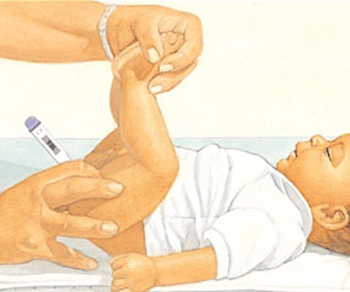Body temperature is an important indicator of human health. Its increase always indicates certain problems in the body. There are different ways to measure body temperature, each of them has its own advantages and disadvantages.
It should be noted that in Russia it is customary to “correctly” measure the temperature in the armpit, and the given temperature standards correspond to just such a method of measurement.
This article will help you understand how to measure the temperature correctly and how important it is.
Where do you measure temperature? Under the arm? In vain - it's not the best place. To help us decide where to stick the thermometer at the first symptoms of influenza and acute respiratory infections, specialists from the University of Örebro (Sweden) were able to. During the study, they measured volunteers' temperature in the armpit, mouth, ear, vagina, and rectum. And who won?
323 patients of the university clinic courageously endured the hardships of the experiment. As it turned out, not in vain. The word "shove" in the end really turned out to be the most appropriate. Scientists have received convincing data that the most accurate result is the measurement of temperature in the rectum. According to scientists, ear thermometry readings distort hair and earwax, it is quite difficult to properly hold the thermometer in the mouth, and deodorant and clothing affect the result of axillary thermometry. But to measure degrees in the rectum, though not very convenient, but for sure. Vaginal thermometry also gives the correct result, but statistics prevented calling this method the most preferable: a little more than 50% of the world's population can use it.
NORMAL TEMPERATURE IN DIFFERENT PLACES
Armpit - 36.3°-36.9°C.
Inguinal fold 36.3°-36.9°C.
Vagina - 36.7°-37.5°C
Oral cavity - 36.8°-37.3°С
Rectum - 37.3°-37.7°C
By the way, the most familiar to us method of measurement turned out to be the most inaccurate. And that's why. Normal armpit temperature does not start at 36.6°C, but at 36.3°C. Normally, the difference between the armpits is from 0.1 to 0.3 ° C. So it turns out that an error of 0.5 ° for axillary thermometry is a common thing. And if the thermometer shows 36.9 ° for several days, and you actually have 37.4 °, this can already be dangerous.
 Not ready to change your habits and switch to the anal way? Then - an educational program about measuring temperature in the armpit. How to measure armpit temperature correctly?
Not ready to change your habits and switch to the anal way? Then - an educational program about measuring temperature in the armpit. How to measure armpit temperature correctly?
- Before putting the thermometer, wipe the skin under the armpit with a napkin. This will reduce the risk of the thermometer cooling down due to sweat evaporation.
- It is necessary to install the thermometer so that the mercury column is in contact with the body on all sides. deep point armpit, without moving anywhere for the entire time of measuring body temperature.
- Make sure that air does not enter the armpit, and the thermometer fits snugly against the skin. To do this, press the shoulder and elbow to the body so that the armpit is closed.
- Measure the temperature for at least 10 minutes (if the thermometer is mercury).
- By the way. Why testimonies electronic thermometer sometimes different from mercury? Because we are using the first one incorrectly. After the device squeaks, it must be held for about a minute - then the result will be correct.
Body temperature is usually measured in cases where a person feels a general malaise. It needs to be measured a couple of times a day - in the morning at 8 o'clock and in the evening at 18 o'clock. More often, you should not perform such a procedure, since measurements twice a day give a complete picture of temperature fluctuations per day.
Temperature is measured:
- Under the arm.
- In the groin.
- In the mouth.
- In the ear
- In the anus.
- Into the vagina.
The difference between rectal and underarm temperature measurements will be discussed below.
Measurement of temperature under the arm
In our country, most often this is the way to measure the temperature, because this method is the most convenient. But also the most unreliable, because it does not give accurate results, unlike measurements in other places of the human body. 
In addition, under the armpits on the left and right, the temperature is not the same and differs by 0.2 ° C. If this figure is higher than 0.5 ° C, then this indicates the presence of inflammation on the side where this figure is higher (or an inaccurate measurement).
- Before placing the thermometer under the armpit, it should be wiped with any cloth (especially in persons prone to heavy sweating). Strong sweating cools the thermometer, as a result, the obtained numbers will be inaccurate.
- The thermometer is positioned so that the entire reservoir of mercury is in contact with the skin under the arm and does not move until the temperature is measured.
- The shoulder joint should fit snugly against the side so that air does not enter the armpit. Small children and patients who are unconscious have to hold their hand in this position while the thermometer is in the armpit.
- An electronic thermometer measures the temperature under the arm for at least 5 minutes, and a mercury one for 10 minutes.
- Normal is the temperature measured under the arm in the range from 36.5 to 36.8 ° C.
By measuring body temperature in the rectum, the measurement result will be most accurate. This is because the anal outlet is quite narrow and fits snugly into the mercury reservoir. And it is the temperature in this hole that is almost the same as that of any of the internal organs. Usually, body temperature is measured by the rectal method in the morning, when a person has just woken up. Any human activity can raise the body temperature in the anus by at least a couple of degrees. 
This method is used when measuring temperature in children of the first years of life, in patients who are too weak due to illness, so they cannot press the thermometer tightly in the armpit. Also, an indication for measuring temperature by the rectal method is a strong hypothermia of a person, when the temperature in the armpits is greatly underestimated, and in the rectum it is close to the temperature of the internal organs.
If the skin is affected in the area of the armpits or there is an inflammatory process, then it is impossible to measure the temperature under the armpits - in this case, the temperature in the rectum is measured. If the patient is unconscious, then his temperature is also measured rectally.
However, there are cases when such a method cannot be used - with constipation, when the anus is filled with feces, with diarrhea, or with a number of diseases in the rectum (hemorrhoids, proctitis and similar diseases).
- Before inserting into the anus, the mercury reservoir must be lubricated with any cream (Vaseline, baby cream, etc.).
- Before this procedure, an adult is laid on his side, and babies - on his tummy.
- The thermometer is gently inserted into the anus to a depth of 3 cm. An adult patient usually does this on his own.
- When measuring the temperature in the rectum, the patient should lie all the time until the thermometer is removed. The thermometer should be held so that it does not slip out. The buttocks should be tightly pressed against each other so that colder air from outside does not penetrate inside.
- The thermometer is inserted only smoothly, without sudden movements, it is not fixed rigidly in the anus, and it should also lie motionless until the temperature is measured.
- A mercury thermometer measures the temperature by the rectal method for 2 minutes.
- body temperature at healthy person with this method of measurement - not higher than 37.7 ° C.
After such a procedure thermometer needs to be disinfected. Before inserting into the anus, the mercury reservoir must be lubricated with any cream (Vaseline, baby cream, etc.).
The thermometer used for rectal measurements should be kept separate from other temperature measuring instruments.
What is the difference between rectal and axillary temperature measurement?
The main differences between rectal and axillary temperature measurements:
- The main difference between these methods of measuring temperature is the place in which the thermometer is placed.
- In addition, these methods differ in the accuracy of the results obtained.
- There are different positions in which the temperature of patients is measured.
- The time it takes to measure temperature with these methods also varies.
- The use of each of the above methods depends on the age and condition of the patient.
Conclusion
The most accurate of all temperature measurements is the rectal method. The temperature measured in the rectum shows the true value of this measurement. In addition, temperature measurements in the rectum and axilla at the same time can help in establishing a diagnosis such as appendicitis. If the first indicator is 10 ° C higher than the second, then the doctors unequivocally speak of inflammation of the appendix in the patient.
Target: determine the body temperature of an adult patient.
Indications: monitoring the functional state of the body, prevention of nosocomial infections.
Equipment: medical thermometer, individual napkin, watch, container with disinfectant solution, temperature sheet, black-tipped pen, temperature log.
Preparation for the procedure:
1. Establish a friendly relationship with the patient, explain to the patient the purpose and course of the procedure, obtain consent.
2. Wash hands and dry.
3. Remove the thermometer from the case, shake it so that the mercury column falls below 35°C.
4. Examine the armpit.
5. Dry the skin in the armpit with a tissue.
Execution of the procedure:
6. Place the thermometer with a mercury reservoir in the armpit so that it is in contact with the skin on all sides.
7. Fix the patient's hand by pressing it to the chest or ask the patient to hold the thermometer by pressing the bent arm.
8. Fix the time of body temperature measurement.
9. Remove the thermometer after 10 minutes.
10. Evaluate the result and inform the patient.
End of procedure:
11. Record readings digitally on the temperature log, then graphically on the temperature sheet.
12. Immerse the thermometer in a container for disinfection.
To measure body temperature in the inguinal fold, the leg is bent at the hip and knee joints, and a thermometer reservoir is placed in the formed fold.
To measure body temperature in the rectum, the child is placed on its side, the thermometer tank is lubricated with petroleum jelly and inserted into the anus by 2-3 cm. During the measurement, the buttocks should be kept in a closed position. Body temperature in the rectum should not be measured in case of bleeding, inflammatory and neoplastic diseases of the rectum.
To measure body temperature in the oral cavity, the reservoir of a medical thermometer is placed under the tongue, and the patient holds the body of the thermometer with his lips.
After measuring body temperature, the thermometer must be disinfected.
The duration of body temperature measurement in the cavities is 5 minutes.
In the hospital, body temperature is measured for all patients, this takes place between 7 and 9 am and 5 and 7 pm. Sometimes it is necessary to measure more frequently 3-4 times a day or every 2 hours.
Fever- this is a protective and adaptive reaction of the body, developed in the process of evolution. It is manifested by an increase in temperature in response to a wide variety of stimuli - microorganisms, tissue decay products, etc.
By lifting degree temperatures are distinguished: subfebrile fever (temperature 37.1-38.0 ° C); moderate, or febrile, fever (38.1-39.0 ° C); high, or pyretic, fever (39.1-41.0 ° C); excessive, or hyperpyretic, fever (above 41.1 ° C).
By the duration of the fever is distinguished: fleeting - from several minutes to 2 hours; acute - from several hours to 15 days; subacute - from 10 to 45 days; chronic - over 45 days.
By the nature of the fluctuations body temperature during the day (sometimes over a longer period), the following types of fevers are distinguished:
1. Persistent fever- persistent for several days or even weeks pyretic (39.1-40.0 ° C) fever with fluctuations during the day no more than 1.0 ° C. Characteristic for typhus and typhoid fever, lobar pneumonia.
2. Laxative fever- febrile (38.1-39.0 ° C) or pyretic fever with daily fluctuations within 2 ° C. It occurs in many infections, focal pneumonia and purulent diseases.
3. Wasting or hectic fever- protracted pyretic or even hyperpyretic (above 41.0 ° C) fever with irregular pronounced daily fluctuations within 3-4 ° C when falling to normal or subnormal numbers, repeated stunning chills, flushes of sweat and rapid emaciation. It is noted in severe pulmonary tuberculosis, sepsis.
4 Perverted Fever- in nature and degree similar to hectic, but in the morning it is noted at the same time Maximum temperature, in the evening - normal. It occurs in severe forms of tuberculosis and sepsis.
5. Atypical fever- characterized by an indefinite duration with irregular and varied daily temperature fluctuations. It is observed in many diseases.
6. Intermittent fever- sudden attacks (paroxysms) of pyretic fever with chills, which after a few hours are also suddenly replaced by fever-free periods lasting 1-3 days. noted in malaria. Similar, but not as regular as in malaria, paroxysms of high fever can be in some other diseases, in particular, in chronic pyelonephritis, calculous cholecystitis, Mediterranean fever (periodic illness).
7. Wave-like fever- proceeds in the form of alternating periods of gradual, over several days, increase in temperature to febrile or pyretic and periods of its gradual decrease to normal or subfebrile temperature. It happens in patients with brucellosis and lymphogranulomatosis.
8. Relapsing fever- characterized by a regular change of febrile and fever-free periods, lasting up to several days, the temperature range in this type of fever can be up to 4-5 ° C. characteristic of relapsing fever.
The type of temperature curve often makes it possible not only to determine the disease, but also to navigate in what course it acquires in the future.
FEVERY PATIENT CARE
The course of fever is divided into three periods: the period of increase in temperature, the period of its maximum rise and the period of decrease. Each of these periods has its own clinical picture, therefore, patient care in each of them has its own characteristics.
During the rise in temperature heat production prevails over heat transfer. The duration of this period is from several hours to several days and even weeks.
Characterized by:
§ chills;
§ headache;
§ aching pains in the whole body;
§ general feeling unwell.
Urgent care
1. Warmly cover the patient.
2. Put a warm heating pad on your feet.
3. Give the patient strong tea.
4. Beware of drafts.
5. Monitor the general condition of the patient.
During the period of maximum temperature rise increased heat transfer and increased heat production are in relative equilibrium. The duration of the period is from several hours to several weeks.
Characterized by:
§ increased toxic state;
§ increased headache;
§ feeling of heat;
§ dry mouth;
§ severe weakness;
§ sometimes agitation and hallucinations.
At this stage, the patient cannot be left alone. The higher the body temperature and the higher its fluctuations, the more the patient is exhausted and his condition is more dangerous.
Urgent care
1. Make sure that the patient does not open up.
2. Put an ice pack or cold compress on your head.
3. Give plenty of fluids (cranberry juice, mineral water, after removing the gases from the bottle).
4. To avoid dry mouth, periodically wipe the mouth with a weak solution of sodium bicarbonate.
5. Lubricate cracked lips with any fat.
6. Monitor your pulse and blood pressure.
During the period temperature drop heat production is reduced, and heat transfer is increased. Rapid, within a few hours, temperature decrease is called crisis, slow, over several days − lysis.
A decrease in temperature, especially a critical one, is difficult for patients to tolerate because of the often occurring acute cardiovascular insufficiency.
The crisis can have a favorable course when the decrease in temperature is accompanied by profuse sweating, the pulse and breathing are not quickened, consciousness is restored, and feverish excitement and insomnia are replaced by sleep.
Characterized by:
§ a sharp drop in blood pressure and slowing of the pulse;
§ profuse sweating;
§ severe weakness;
§ cold extremities;
§ cyanosis of the lips.
Urgent care
1. It is good to cover and warm the patient.
2. Put warm heating pads around your arms and legs.
3. Give the patient a drink of strong tea or coffee.
4. With profuse sweating, change underwear, and if necessary, bed linen.
5. Give the patient plenty of fluids (fruit drink, juice, water, etc.).
6. All physiological functions should be performed in bed.
7. With a sharp drop in blood pressure, you must urgently call a doctor.
In most cases, the temperature drops lytically - gradually, which is accompanied by the appearance of a slight perspiration on the skin and weakness. Usually, after the temperature drops, the patient falls asleep. You shouldn't wake him up.
TEST QUESTIONS
1. What is the normal body temperature of a person, measured in the armpit?
2. What determines the temperature of the human body?
3. What is thermometry?
4. What is a fever?
5. List fevers according to the degree of rise in body temperature.
6. What types of fevers do you know by the nature of the fluctuations?
7. List the periods of fever.
8. Name the duration of the first period of fever.
9. What worries the patient during the second period of fever?
10. What is the name of the decrease in body temperature within an hour?
CONTROL TASKS
1. The patient has a body temperature of 41.0°C, he is agitated, delirious, there is a blush on his cheeks.
2. The patient complains of poor health, "ache" in the whole body, headache, he is cold, he can not get warm in any way. Body temperature 40.3°C. What period of fever is the patient in? your tactics.
3. The patient was given antipyretic drugs at a body temperature of 41.3°C. After 20 minutes, the temperature dropped to normal, but the patient's condition worsened: there was a sharp weakness, thready pulse, cold extremities, linen (bed and underwear) wet with sweat. What period of fever is the patient in? your tactics.
CONTROL TESTS
1. In the development of fever, __________ periods are distinguished.
a) four
2. Subfebrile body temperature (in degrees C):
a) 39.1-40.0°С
b) 38.1-39.0°C
c) 37.1-38.0°C
d) 36.1-37.0°С
3. Fever that lasts several hours:
a) chronic
b) subacute
c) sharp
d) fleeting
4. Decrease in body temperature for several days:
a) crisis
b) febrile
d) subfebrile condition
5. In the first period of fever, it is possible to use:
a) wet wrap
b) heating pads
c) cold compress
d) ice pack
6. Body temperature during the day fluctuates within (in ºС):
7. The duration of the measurement of body temperature in the armpit is not less than (in minutes):
8. The body temperature of a healthy adult is (in ºС):
9. The main symptom of the first period of fever:
c) feeling hot
10. Physiological body temperature is often lower:
c) in the evening
ACTIVITY #4
"METHODS OF THE SIMPLE PHYSIOTHERAPY"
The purpose of self-training:
Familiarize yourself with the concept of simple physiotherapy and learn the technique of conducting simple physiotherapy.
Physiotherapy- targeted impact on the human body with a therapeutic purpose by various natural physical factors: water, heat, cold, light, electricity, electromagnetic field, ultrasound, etc.
Physiotherapy procedures are measures of influence on blood circulation. It is known that the skin is equipped with a large number of nerve endings, so it is possible to influence blood circulation on the principle of reflex reactions from the skin to internal organs. When the skin receptors are irritated by heat, the blood vessels expand, and when exposed to cold for a short time, the blood vessels narrow.
Methods of simple physiotherapy reflexively affect the entire body, including internal organs. This is the basis for the use of mustard, cans, leeches, cold, heat, light and hydrotherapy.
STATEMENT OF MUSTARD STICKS
The mechanism of action of mustard: essential mustard oil penetrating the patient's skin, irritates it and dilates the skin blood vessels, leads to a reflex expansion of the blood vessels of the internal organs.
Indications: with pain, acute inflammatory processes of the respiratory system, pneumonia, bronchitis, pleurisy, diseases of the muscles, nervous system, neuralgia, neuritis, osteochondrosis, hypertensive crisis, with pain in the heart.
Contraindications: bleeding, skin disease, tumors of various etiologies, allergic reactions to essential oils, violation of the integrity of the skin, hyperthermia.
Possible complications: with prolonged exposure to mustard plasters, a skin burn with the formation of blisters is possible.
Equipment: factory-made mustard plasters, a kidney-shaped tray with warm water, a towel, cotton wool, a thermometer.
Preparation for the procedure:
1. Establish a trusting relationship with the patient.
2. Explain the purpose and course of the procedure, clarify their understanding, obtain consent to the procedure.
3. Wash and dry your hands.
4. Make sure that mustard plasters are suitable (look at the date of manufacture and expiration date).
5. Invite the patient to expose his back, give a comfortable position in bed, examine the skin.
6. Put a tray with warm water next to the bedside table or stool, measure the water temperature, it should be 40-45ºС.
Execution of the procedure:
7. Dip the mustard plaster in warm water for 5-10 seconds, shake off excess water.
8. Apply the mustard plaster to the desired area of the skin with the side covered with a layer of mustard, put a towel on top.
9. Cover the patient with a blanket, note the time.
10. Keep mustard plasters for 10-15 minutes.
Completion of the procedure:
11. Remove the mustard plasters, remove the remaining mustard with a piece of cotton wool moistened with warm water.
12. Make sure that on the skin, in the places where mustard plasters are applied, there is a distinct hyperemia.
13. Wipe the skin dry with a towel, remove care items.
14. Warn the patient to stay in bed for about 30 minutes.
15. Wash and dry your hands.




